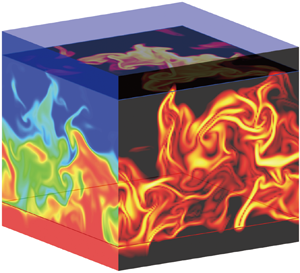No CrossRef data available.
Article contents
Reactive scalars in incompressible turbulence with strongly out of equilibrium chemistry
Published online by Cambridge University Press: 15 March 2022
Abstract

We study the statistical properties of scalar fields undergoing reversible chemical reactions in a turbulent environment by means of numerical simulations. To produce strong chemical fluctuations in a wide region of the domain, an original flow configuration has been proposed, where the species are supplied from buffer boundaries with adjustable thickness, while the flow is developed homogeneous and isotropic turbulence in a periodic domain. With the presence of the mean scalar gradient in the bulk region, the strength of turbulent advection is comparable with the chemical source, which is quantified by the Damköhler number. Our analysis focuses on the global and spatial properties of the reactive scalars in their statistically steady regime. We show how for the case of a second-order reaction such features can be connected to the properties of a non-reactive scalar field advected in the same system. Analytical predictions of the scalar moments in the fast reaction regime agree satisfactorily with the direct numerical simulation results. In comparison with the existing results of the isotropic turbulence case, we conclude that the scalar correlation is jointly determined by both the chemical source and the flow configuration. Moreover, the chemical reaction also plays an important role in determining the scalar energy spectra.
- Type
- JFM Papers
- Information
- Copyright
- © The Author(s), 2022. Published by Cambridge University Press





